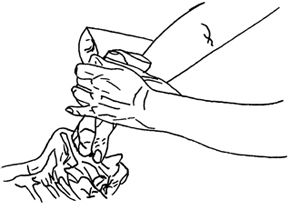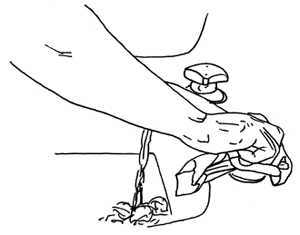G1233
Food Safety for Child Care Facilities
This NebGuide outlines proper techniques for providing safe food in child care facilities.
Julie Albrecht, Extension Food Specialist
Children are at high risk for food-borne illnesses. Young children are particularly vulnerable to microbial food-borne diseases because of their under-developed immune systems.
In recent years, reports of food-borne illnesses have made headlines. Most of these outbreaks involved food prepared away from home. Many cases of food-borne illness go unreported because the symptoms are similar to the flu.
Foods contaminated with microorganisms cause food-borne illnesses. Contaminated food does not, however, always taste bad, smell bad or look bad. Therefore, it is almost impossible to detect contamination.
We refer to foods implicated in food-borne illness outbreaks as potentially hazardous foods. These foods include:
- Meat and poultry
- Eggs and egg products
- Milk and milk products, including pastries with cream or custard fillings
- Home-canned, low-acid foods such as vegetables and meats
What food handling practices contribute to food-borne illnesses? By examining reported food-borne illness outbreaks, we find clues of how microbial contamination occurs. The evidence points to the following 10 factors:
1. Improper Cooling.
- Leaving cooked foods at room temperature — food-borne microorganisms grow best at temperatures between 41° and 135°F. Microorganisms will multiply rapidly in foods left at room temperature for more than two hours. Do not leave baby bottles containing formula or milk setting at room temperature. Discard partially consumed milk or formula.
- Storing foods in large containers in refrigerators — hot food stored in large containers in refrigerators or freezers does not cool down quickly, conditions that favor rapid growth of microorganisms. Store foods in small, shallow containers. Refrigerate foods promptly.
2. Lapse of 12 or More Hours Between Preparation and Eating.
Microorganisms need to grow and multiply. By reducing the time between food preparation and eating, you will keep any microorganisms present from growing to large numbers.
Reheat leftovers to 165°F and eat immediately. Discard food left on children’s plates.
3. Colonized or Infected Persons Handling Foods.
Staphylococcus bacteria are found naturally on our bodies. Wash hands often when handling raw foods such as poultry and meats. Always wash hands after coughing or blowing noses, after handling garbage, and after changing a diaper.
Proper hand washing includes washing hands with soap (preferably liquid) and warm water. Rub hands together for 20 seconds. Rinse and dry hands with a paper towel.
Sores or pimples contain large amounts of staphylococcus bacteria. Also, people who are ill have higher numbers of microorganisms in their bodies that may lead to food-borne illnesses if they handle food without taking proper precautions.
Avoid touching your hair or face when handling food. Also, wear plastic gloves to protect the food if you have cuts or sores on your hands.
4. Inadequate Reheating.
Cooked foods may become contaminated after heating. To destroy any microorganisms, reheat cooked foods to at least 165°F.
Although a microwave oven heats food quickly, it does so unevenly. To heat foods adequately in a microwave oven, interrupt heating both to stir the food and rotate the dish. Preheat foods in a microwave to at least 165°F.
5. Improper Hot Holding.
Temperatures below 135°F encourage the rapid growth of microorganisms in food. Avoid leaving food at room temperature for any time.
Remember the two-hour rule: Do not keep food for more than two hours in the danger zone (41° to 135°F). The two-hour limit includes preparation and serving time.
6. Contaminated Raw Food or Ingredients.
Foods produced in manure and dirt, such as eggs and produce grown with manure fertilizers, contain many microorganisms. Consider cracked eggs contaminated. Wash foods to remove dirt and manure.
Avoid feeding an infant out of the baby food jar, unless the child eats all of the food. The baby’s saliva may contaminate the unused portion.
7. Foods From Unsafe Sources.
Encourage parents to bring purchased foods, rather than homemade foods, as treats.
For example, a parent may unknowingly mishandle homemade cupcakes with a pudding center and leave them at room temperature for more than two hours. The cupcakes could cause a food-borne illness outbreak if you serve them to the young children in your care.
8. Improper Cleaning of Equipment and Utensils.
Microorganisms will survive for some time in food left on work surfaces, equipment and utensils. When you use the equipment or utensil again, you transfer the microorganisms to the next food.
Wash cutting boards, utensils, and food contact surfaces with hot, soapy water. Sanitize if necessary. (See the following section entitled “Sanitizers.”)
9. Cross Contamination From Raw to Cooked Foods.
Do not allow juices from raw meat and poultry to contact cooked food. Raw fruits and vegetables also can contaminate cooked foods. Wash these foods well before serving.
Store cooked foods above raw foods in the refrigerator. For example, meat juices from raw meat could drip into an uncovered salad. If possible, keep food covered in the refrigerator.
It is important to wash hands often. Be sure to clean equipment, utensils, and work surfaces after handling meat, poultry, and raw fruits and vegetables.
10. Inadequate Cooking.
Consuming undercooked meats and poultry has resulted in food-borne illness outbreaks. Thoroughly cook poultry and items that contain ground beef, pork, turkey, or chicken. Cook poultry to an internal temperature of 165°F for 15 seconds. Heat pork to an internal temperature of 145°F for 15 seconds. Ground beef is done when it reaches an internal temperature of 155°F for 15 seconds, or when no pink color remains. Cooked meat juices should be clear.
Avoid using home-canned foods in your child care facility. The most serious cases of food-borne illnesses occur because of improperly processed, home-canned, low-acid foods. The botulinum microorganism spores can survive boiling water temperatures. Improperly canned, low-acid foods may contain the deadly toxin these spores produce.
Sanitizers
Good housekeeping is important. Many types of commercial cleaning and sanitizing solutions are available.
Also, you may use a chlorine bleach solution to sanitize dishes after washing. Use a stronger bleach solution to wipe down and sanitize food contact surfaces.
- Sanitizing solution for dishes — 1 teaspoon of chlorine bleach to 1 gallon of warm water
- Sanitizing solution for food contact surfaces — 1 tablespoon of chlorine bleach in 1 gallon of warm water
Because the chlorine solution breaks down easily and loses effectiveness, mix it fresh daily. Do not mix chlorine bleach with such liquids as vinegar or ammonia. This will produce harmful gases.
No matter what types of cleaners you use, store them and all chemicals (insecticides and other household cleaners) away from food.
Resources
Contact your local Extension office for more publications about safe food-handling practices.
Visit the University of Nebraska–Lincoln Extension Publications Web site for more publications.
Index: Foods & Nutrition
Safety
1994, Revised April 2007





